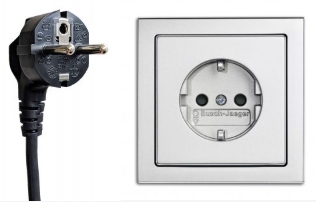Power plug & outlet Type F
Date:2022-07-14 Click:2239 Source:Caron
TYPE F

Type F is used, for instance, in Germany, Austria, the Netherlands, Sweden, Finland, Norway, Portugal, Spain and Eastern Europe.
Plug F is known as CEE 7/4 and commonly called “Schuko plug”, which is the acronym of “Schutzkontakt”, a German word meaning “protection contact” or “safety contact”. The plug was designed in Germany shortly after the First World War. It goes back to a patent (DE 370538) granted in 1926 to Albert Büttner, a Bavarian manufacturer of electrical accessories.
Type F is similar to C except that it is round and has the addition of top and bottom indentations with conductive clips in them in order to earth the appliance. The plug is not perfectly round, but has a pair of plastic notches on the left and right side to provide extra stability when using large and heavy plugs (e.g. with built-in transformers).

Obsolete type F plug, i.e. without an earthing hole to accept the earth pin of the type E socket.
The plug has two 4.8 mm round pins, measuring 19 mm in length on centres spaced 19 mm apart. The distance between either of the two earthing clips and the middle of the imaginary line connecting the centres of the two power pins is 16 mm. Because the CEE 7/4 plug can be inserted in either direction into the receptacle, the Schuko connection system is unpolarised (i.e. line and neutral are connected at random). It is used in applications up to 16 amps. Above that, equipment must either be wired permanently to the mains or connected via another higher power connector such as the IEC 60309 system.
Type F plugs are fully compatible with type E sockets. This was not the case in the past, but fortunately common sense prevailed. A hybrid E/F plug (officially called CEE 7/7) was developed in order to bridge the differences between E and F sockets. This plug, which is basically the earthed universal Continental European standard, has earthing clips on both sides to mate with the type F socket and a female contact to accept the earth pin of the type E socket. The original type F plug, which does not have this female contact, is now obsolete, but a rewireable version may still be available at some DIY shops. A type C plug fits perfectly into a type F socket. The socket is recessed by 15 mm, so partially inserted plugs do not present a shock hazard.

